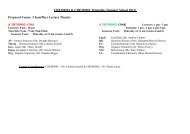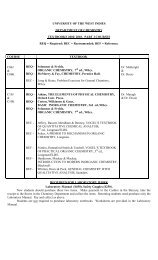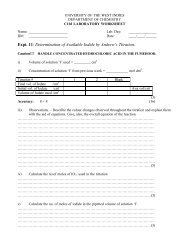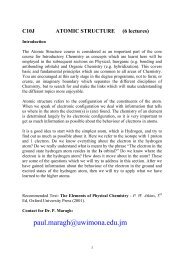faculty of pure and applied sciences - The Department of Chemistry ...
faculty of pure and applied sciences - The Department of Chemistry ...
faculty of pure and applied sciences - The Department of Chemistry ...
Create successful ePaper yourself
Turn your PDF publications into a flip-book with our unique Google optimized e-Paper software.
Filtered extracts were partitioned in acetonitrile, cleaned in a florisil column <strong>and</strong> concentrated foranalysis according to the methodology described by Robinson (1997). Identification <strong>and</strong>quantification <strong>of</strong> residues were done by a Shimadzu 9A gas chromatograph equipped with an FPD.Analytical conditions were: glass column, 1.6 m by 2 mm packed with OV-17; carrier gas, nitrogen,at a flow rate <strong>of</strong> 30 - 35 mL/min; temperature settings - column 230 o C, injector <strong>and</strong> detector 260 o C.Detection levels ranged from 0.001 - 0.002 ng.Fish exposed to 0.005 mg/L chlorpyrifos in fresh water accumulated only 35% (1.35 mg/g) <strong>of</strong> theinsecticide within the first 2 hr. Accumulation fluctuated thereafter, reaching a maximum <strong>of</strong> 3.87mg/g after 48 hr <strong>of</strong> exposure followed by a decline within the next 48 hr to 2.45 mg/g. At higherconcentration (0.05 mg/L), there was rapid accumulation <strong>of</strong> chlorpyrifos by the fish as 51% (0.86mg/g) <strong>of</strong> the total 72-h accumulation <strong>of</strong> the insecticide was achieved after 1 hr <strong>of</strong> exposure. Uptakethen fluctuated before rapidly increasing to1.68 mg/g at the end <strong>of</strong> the 72-hr exposure period.<strong>The</strong>re was a two-fold accumulation <strong>of</strong> chlorpyrifos by fish in brackish water compared with freshwater as maximum bioconcentration (0.96 mg/g) in brackish water was achieved after 1 hr <strong>of</strong>exposure. Accumulation <strong>of</strong> the insecticide subsequently declined to 0.39 mg/g at the end <strong>of</strong> the 72-hrexposure period (Table). An unidentified organophosphorus metabolite <strong>of</strong> chlorpyrifos was alsodetected within 1 - 2 hr <strong>of</strong> exposure to the insecticide in fresh <strong>and</strong> brackish water.<strong>The</strong> rapid uptake <strong>of</strong> chlorpyrifos by Tilapia is consistent with the relatively high octanol-waterpartition coefficient (logKow = 4.82) <strong>of</strong> the insecticide which suggests that it readily partitions in fishtissues. Although the rapid formation <strong>of</strong> the metabolite implies that the chemical is quicklybiotransformed, the toxicity <strong>of</strong> this metabolite to the fish is unknown. Thus, further studies areneeded, including the elimination <strong>of</strong> the parent compound <strong>and</strong> its metabolite by the fish.ReferencesMansingh, A., Robinson, D.E. <strong>and</strong> Dalip, K.M. (1997). Insecticide contamination <strong>of</strong> the Jamaicanenvironment, Trends in Anal. Chem. 16 (3): 115-123.Robinson, D. E., Mansingh, A. <strong>and</strong> Dasgupta, T. P. (1997) Fate <strong>of</strong> endosulfan in river <strong>and</strong> coastalwaters <strong>of</strong> Jamaica. Proc. Int. Symp. on the Use <strong>of</strong> nuclear <strong>and</strong> related techniques forstudying environmental behaviour <strong>of</strong> crop protection chemicals, IAEA, Vienna, July 1 - 5,1996. pp. 301-311.Robinson, D.E. (1997). <strong>The</strong> fate, biological impact <strong>and</strong> management <strong>of</strong> endosulfan <strong>and</strong>ethoprophos in the Jamaican environment. Ph. D. <strong>The</strong>sis. Univ. West Indies, Mona,Jamaica. 289 pp.Witter, J.V., Robinson, D.E., Mansingh, A. <strong>and</strong> Dalip, K.M. (1998). Insecticide contamination <strong>of</strong>Jamaican environment. V. Isl<strong>and</strong>-wide rapid survey <strong>of</strong> residues in surface <strong>and</strong> groundwater. Environ. Monitor. & Assess. (In press).33










